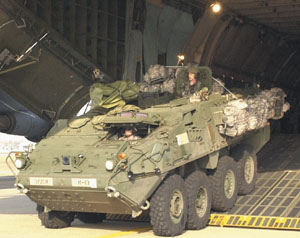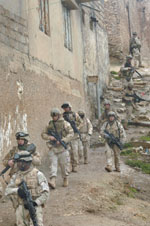U.S. Army Reforges Training and Readiness.
 |
| The U.S. Army’s force generation (ARFORGEN) model will facilitate the transition of the service’s formations to modular units. Based on brigade combat teams, they can be deployed more rapidly to global trouble spots and be quickly combined into mission-specific forces. |
The new initiative that is reshaping U.S. Army forces into smaller, more flexible formations allows them to realign themselves to meet commanders’ mission requirements. The process changes how the service trains, refits and equips its active duty and reserve components as they rotate out of an operational theater. The modified units not only meet Army transformation requirements but also are tailored to perform specific types of missions.
The U.S. Army Forces Command (FORSCOM),
This approach has ramifications for technology insertion. Individual soldiers must receive the newest technologies or the transformation will not be as effective as designed. Modular forces must continue to receive gear that supports armywide or defensewide communications and information system programs. And, their soldiers must be trained to operate a range of different types of equipment as the force and its capabilities undergo change.
The ARFORGEN model changes the Army’s readiness and deployment architecture, which dictates how the Army prepares forces for major combat operations and supports forces in the field. Gen.
The new process allows the Army to increase its force generation capability by simultaneously providing and supporting forces and by meeting its strategic commitments and the nation’s global military requirements. Gen.
An important feature of ARFORGEN is that units are tasked, trained and sustained to meet specific mission requirements. This new model is a change from the Cold War era system of tiered readiness for active duty and reserve forces. The old method supported units at varying levels of readiness, which determined the kinds of equipment and manning they received. “You had a situation where you had haves and have-nots,” he says.
Citing a personal example, Gen.
Gen.
Units are grouped into three pools: a reset and train pool, a ready pool and an available pool. As forces progress through each category, units are provided with the facilities, personnel and equipment they need. He notes that all units will fall into one of these three pools. The most trained and ready units fit for deployment and contingency operations will be in the available pool, while troops in the ready pool can be tapped to meet emergency surge requirements. The new model applies to both active and reserve components of the service. “This is a much better process that will enable us to meet the worldwide requirements that are today’s reality,” he says.
 |
| Ongoing military missions such as patrols in Iraq require a continuous flow of new units as old ones are rotated back to the United States. Overseen by the U.S. Army Forces Command, the ARFORGEN system establishes a timetable for active duty and reserve forces to be re-equipped, trained and readied for new operations. |
Rotation cycles will vary for individual units as they move through the three ARFORGEN pools. The process will take roughly three years for active forces and up to six years for reserve units. “In an objective state, you might have a deployment for an active component force once in three years and once in six years for a reserve unit. Given the current operational needs, we are not able to do that right now simply because the inventory [of people] is not there to meet all the requirements and still stretch it [rotation cycles] out over that length of time,” he says.
The general adds that the Army currently is operating on a compressed time line as ARFORGEN is being implemented. He believes that in time, as some of the service’s operational requirements change, it will be able to reach the model’s optimal state with deployments following three- and six-year patterns.
The model is brigade-combat-team-centric. The general explains that enabling forces supporting and deploying with a brigade combat team will be smaller in size and fewer in number. Depending on operational requirements, these forces may have more operational time than a brigade combat team that may be deployed once every three years.
FORSCOM manages the transition to a modular force through two semiannual conferences held in
Modular units going through the force generation process will be matched against Army requirements with the transformation time line taken into account. These needs can include U.S. Central Command requirements that are validated by the Army Joint Staff and then sent to the U.S. Joint Forces Command for sourcing.
The general notes that this is a formal process built into the model. “There are certain efficiencies that are gained when you go from an Army of Excellence [Force XXI] to a modular formation. Depending on the type of unit, in some cases, your requirement is less as you transition. So you might have a smaller force to deal with in some cases; it just depends on the type of unit, but it doesn’t really change the process,” he says.
But wartime conditions are putting a strain on the command’s efforts to provide trained and ready forces. Key issues include synchronizing training activities and lining up resources to provide the best possible solutions for units readying to deploy. He explains that meeting the Army’s operational needs for personnel and equipment can be challenging. “The easy solutions are over,” he declares.
Because individual readiness is a vital element of unit preparedness, FORSCOM supports a variety of virtual simulations for soldiers. One system in high demand is the virtual convoy combat trainer. The general adds that simulation technologies are aiding the
Another major responsibility of FORSCOM’s transformation is ensuring that refitted forces receive the latest equipment such as personal radios and handheld devices for individual soldiers. The command also is involved in the integration of next-generation systems such as the Warfighter Information Network–Tactical and Joint Tactical Radio System programmable digital radios. Gen.
FORSCOM also participates in a variety of forums with representatives of the Stryker vehicle program to prepare forces for readiness and deployment. The general explains that the command plays an important role in ensuring that units have the latest technology available to them before they deploy. “We are really a command that is involved with the transformation effort—both in structure and in terms of modernizing equipment,” he says.
In addition to employing technology enhancements to support the ongoing transformation, Gen.
FORSCOM’s support of transformation efforts is part of the Army’s campaign plan that outlines how the service meets its transformation goals. Depending on individual units and their rotation schedules, Gen.
The campaign plan defines the planning, preparation and execution of operations and transformation. This process is managed via a series of weekly meetings hosted by senior Army leadership. The general notes that the plan sets the time line for the transformation of Army units to brigade combat teams and its entire service structure. It is FORSCOM’s responsibility to implement the instructions dictated by the plan. A weekly dialogue identifies and mediates issues arising from equipping, manning and stationing forces. “It’s a pretty thorough process. The forums have been developed where we really talk not only about unit readiness but about time lines for transforming units,” the general states.
When a unit is restationed, the receiving command’s ability to accept it and the restationing command’s ability to move the unit are discussed. The larger the unit, the greater the visibility, he notes. Because many units are rotating around the world due to the current operational situation, this process requires daily attention. For example, the 3rd Infantry Division has just redeployed from its latest rotation in
Web Resources




Comments